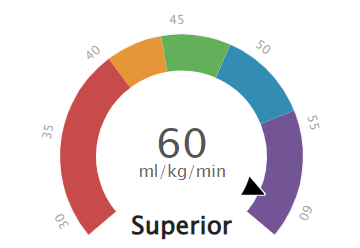Be Wary of VO2 Max Estimates
An athlete recently asked me what my Garmin VO2 max was. I could see the disappointment as I explained all the caveats and why little emphasis should be put on that number. VO2 max estimates are interesting but not something to obsess over, largely because of how the calculation is done. If for some reason you really need to know your true VO2 max, you’ll need to head to a lab and be prepared for a very tough treadmill running session.
Garmin asserts that, “When it comes to understanding your VO2 max score, it is easy to remember that low VO2 max scores represent poor fitness levels, and higher VO2 max scores indicate greater performance capacity.” In general terms this is true, but Garmin estimates are just estimates, so please don’t train with an eye towards raising the score. Garmin estimates your VO2 using a formula taking into account running pace and heart rate as a percentage of your max heart rate. If your max heart isn’t accurate, then your VO2 max score won’t be valid and could be up to 10% off. If your heart rate data from a run is inaccurate because your wrist-based sensor lags or isn’t functioning well, your VO2 max estimate won’t be valid.
True VO2 max is measured with body weight as a denominator, so if you care about improving the accuracy of your Garmin estimate, make sure you keep your body weight current in your Garmin Connect profile.
The biggest problem I’ve noticed with the VO2 max estimate is that it fails to account for interval work. For example, a 30 minute tempo run at a hard pace will likely bounce up your VO2 max because Garmin will see a solid pace and a decent heart rate based on your current fitness level. But run an 8 minute on, 2 minutes off tempo workout just as hard and Garmin will likely LOWER your VO2 max score because the formula sees a high heart rate at a very low speed during those 2 minute recovery jogs. Your fitness hasn’t changed, but Garmin perceives you as failing to hold tempo pace even though you eased back voluntarily. I’ve seen my own estimate drop by as many as 5 ml/kg/min after training blocks where threshold work was more interval based than steady state.
Remember that the most important running metrics are your race times and your enjoyment level. VO2 max estimates are more distracting than helpful.

